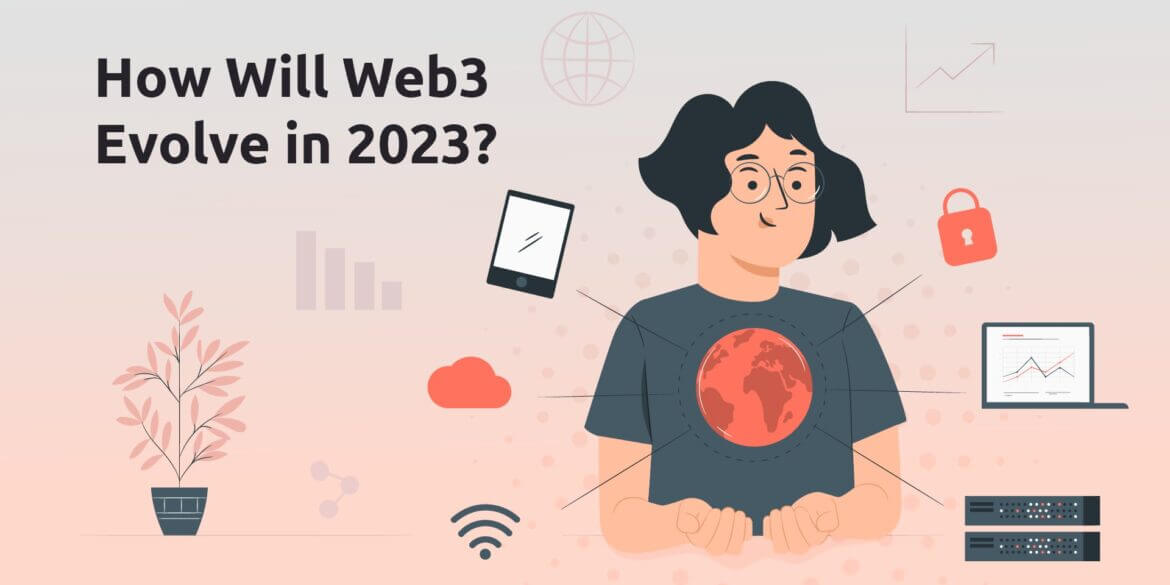For many Web3 technology lovers, 2022 was an extremely trying year. The community has seen the rise & fall of interest in NFTs, major cryptocurrencies have experienced important price declines, and the collapse of FTX had a significant impact on the entire sector. Alongside all the drawbacks in the market, an increasing number of businesses want to influence Web3 technology.
Web3 technology trends are growing remarkably quickly, indicating that they are important for any brand. The next phase of the web will bring revolutionary development and alterations in usage. The so-called decentralized web is made up of a variety of patterns that are included in Web3. Blockchain is used to keep user data secure and encrypted so that no one can access it, as opposed to corporations owning it and exploiting it for their own purposes. In Web3, a business strategy is necessary in addition to the transformation of advertising and further research in software engineering.
Redefine Your Business with Digital Transformation
Innovative Digital Solutions, Designed for Your Unique Needs
Explore Digital TransformationWhy should brands pay attention to Web3 trends in 2023?
According to the Web3 philosophy, technological developments like blockchain, digital currencies, NFTs, and decentralized autonomous organizations (DAOs) give brands and users the tools they need to create online spaces that are uniquely their own, as well as to implement digital democracies.
The upcoming Web evolution will make use of encryption to better safeguard and protect users’ personal data. Additionally, blockchain technology is used to guarantee that user-to-user transactions are secure. The blockchain offers a trustworthy source of assurance for facts because it can produce an immutable record of transactions and activity. The market’s potential for development and growth is what makes Web3 technology so important.
The estimated value of the global Web3 market in 2021 was $1.36 billion, and it is anticipated that between 2022 and 2030, it would grow at a CAGR (compound annual growth rate) of 44.9%. This expansion might be ascribed to the rising demand for data security via Web3’s decentralized identity as well as the developing internet technologies.
Experience Expert IT Consultancy
Transformative Strategies for Your Technology Needs
Discover IT ConsultingAlong with the introduction of 5G or 6G technology, the rapid increase in the utilization of digital assets is also likely to contribute to the rise. Additional factors supporting the future of Web3’s blockchain market are the rising use of connected devices and improved transaction processes. This might boost Web3 technology, specifically its adaptability and interaction in a way that makes it possible to reach wider audiences than ever.
Web3 and the metaverse are not the same, despite the fact that many people mistakenly lump them together. The term “metaverse” generally alludes to a virtual environment that is still primarily theoretical, whereas web3 is already popular & very much in use. Some Web3 technologies, like NFTs, have gained widespread societal acceptance over the past few years. Web3 is undergoing a period of rapid and profound change that could lead to significant advancements in 2023. Discover more interesting information and find out “What is an NFT?”.
We present you 10 predictions for how web3 technology will evolve and most likely shape the future of the internet:
1. Legal adjustments in the Web3 field
Decentralized banking, also known as DeFi, will be one of the main Web3 development areas in 2023. Despite all the development in this field over the past few years, the regulations for Web3 are still in flux. For instance, smart contracts are still not enforceable by law. As demonstrated by the FTX crash, more protection for cash held in custody is one thing that can be expected. Therefore, more rules are expected to be implemented, particularly for centralized crypto exchanges.
Given that Web3 is a decentralized structure of services, governance is a very complex topic in any format. Most likely, community-based organizations will manage the area rather than individual financial institutions. The type of government will presumably be decentralized, allowing each member of the society to express themselves.
Financial institutions were pushed last year to reevaluate how they handle compliance monitoring for cryptocurrency transactions. Demand for fraud prevention & transaction monitoring services that catch fraud, like money laundering operations, is projected to increase.
2. Interoperability
Web3 technology is dependent on interoperability. Applications are currently isolated on the Internet, making it unable to expand upon them for progress. Applications in Web3 can be expanded upon without permission, and users can carry their information with them wherever they go. This results in a digital economy that can innovate more quickly, is more flexible, and is more resilient. In order to deliver a smooth experience, interoperability in Web3 is the process of integrating various virtual environments, platforms, and applications. The two key benefits of Web3 interoperability for brands are security & extensibility.
3. Modifying how crypto is viewed
The general public has been perceiving cryptocurrency as an investment for the last several years. In the past, people believed that cryptocurrencies would make them wealthy. However, the crypto winter of 2022 altered how people view cryptocurrencies because many individuals lost money as a result of the mid-year collapse of cryptocurrencies or the failure of the FTX exchange.
However, we see cryptocurrency becoming more of a tool for Web3 services and less of an investment.
4. Lowering a transaction’s cost
Now, any platform is evaluated using fundamental criteria including security, speed, and transaction cost. Some technology protocols are too pricey for the general public because of transaction costs, which are a crucial component.
For instance, on Ethereum, a platform for general-purpose smart contracts, gas prices prohibit users from accessing the network, which has a severe negative impact on network scalability. People frequently use networks with lower resilience while looking for less expensive alternatives. Ethereum executed an EIP-1559, sometimes referred to as the London Hard Fork, in August 2021 to increase the predictability of gas fees.
Nevertheless, due to the lack of significant differences in predictability, it was not a particularly effective approach. There will probably be further initiatives to lower transaction costs.
5. Social media based on Web3
Users can have more control over their data due to the downfall of centralized social media sites like Facebook and Instagram. Decentralized social media brings a solid advantage for Web3 because of this. Building connections with influencers & businesses is made easier by digital assets and Web3 IDs. Similar to this, Web3 social media gives influencers and companies a multitude of avenues to connect with their clients, ensuring that they get the most exposure possible. This improves their fan interactions, which boosts their revenue. Additionally, with NFTs for fair pricing, decentralized social media networks offer better revenue strategies for producers.
Some crypto-savvy users are switching from traditional social media to recently developed Web3-based ones, which has been quite advantageous for projects and businesses. One Web3 application that helps communities grow and thrive is Crew3. The future of Web3 social networking platforms might resemble such apps more than the ones currently in use.
6. Decentralization is expanded
Despite the advancements in blockchain technology, many Web3 technology and infrastructure services remain overly centralized. Centralized systems are more susceptible to hardware and software failure, raising the risk of service uptime and security breaches. A system is more reliable when there isn’t one single failure point.
7. Improved Web3 service user experience
Many Web3 solutions today, including DeFi protocols, have complicated user interfaces. Due to poor UX, Web3 solutions are unable to gain widespread acceptance. In 2023, web3 designers began to embrace user-centered design , putting the user’s demands first. The custody and asset servicing processes, as well as clearing, will probably be improved.
Invest in Professional UX/UI Design to Create Impactful Interfaces
Designing Seamless User Journeys That Boost Interaction and Conversion Rates
Discover UI/UX DesignThe developers of Web3 services will put more time & effort into UX design services and train new customers on how to use their goods, boosting the transparency of their services and recycling current design patterns to produce recognizable designs.
8. Web3 offers a more decentralized digital identity
We’ll probably start hearing more about decentralized digital identification. Digital wallets currently act as independent identities, but this trend is expected to continue. When using Web3 platforms, users can decide how to share their personal data, what information to offer, and to whom. A digital decentralized identity is the first step toward a digital avatar, a graphical illustration of a user in a virtual world that will be used in the Metaverse.
9. The metaverse’s evolution
A metaverse, or totally virtual parallel universe, is constructed using Web3 technology. The metaverse is the next iteration of a platform being developed by businesses, including Microsoft, Nvidia, and Meta. The metaverse will differ from all previous virtual platforms in that it will provide users with a sense of ownership over their digital possessions. Users continue to be interested in the Metaverse despite widespread skepticism about it in the tech community, especially among younger audiences who are more likely to be digital asset owners.
Advanced R&D Solutions Tailored for Your Business Growth
Innovation Is at the Core of Every Product Through R&D-Focused Software Development
Learn About R&D ServicesThere is a probability that the idea of NFT, a special digital object with verifiable ownership, will serve as the metaverse’s building block. The market for digital goods is already enormous, with an estimation of billions of dollars. The ability for users to govern their assets makes NFTs ideal for the virtual world. New categories of digital assets, including tokenized real estate, may also become more common.
The way we view fashion will likewise alter as a result of the metaverse. In the Metaverse, new fashion trends will form and spread to the real world. Brands like Nike and Balenciaga have already begun looking into virtual goods as a potential new source of income. If you find metaverse’s evolution interesting, learn more about the many metaverse use cases.
10. The future of Web 3: greener & sustainable
One of the primary obstacles to blockchain’s widespread use has been the high energy costs associated with operating it. Web3 businesses are now emphasizing the need to use environmentally friendly methods and products.
Web3 technology will keep evolving while the efforts of the community will be focused on working to cut carbon emissions. The objective is to lower the amount of energy needed to run web3. By transitioning from a proof-of-work towards a proof-of-stake algorithm, Ethereum demonstrated that it is feasible and resulted in a 98% decrease in the total amount of energy used on the network.
If you want to be part of Web3’s future, we encourage you to book a meeting with HyperSense to discuss web development projects and software solutions. Contact us to learn more about what we do and how we can help you.










